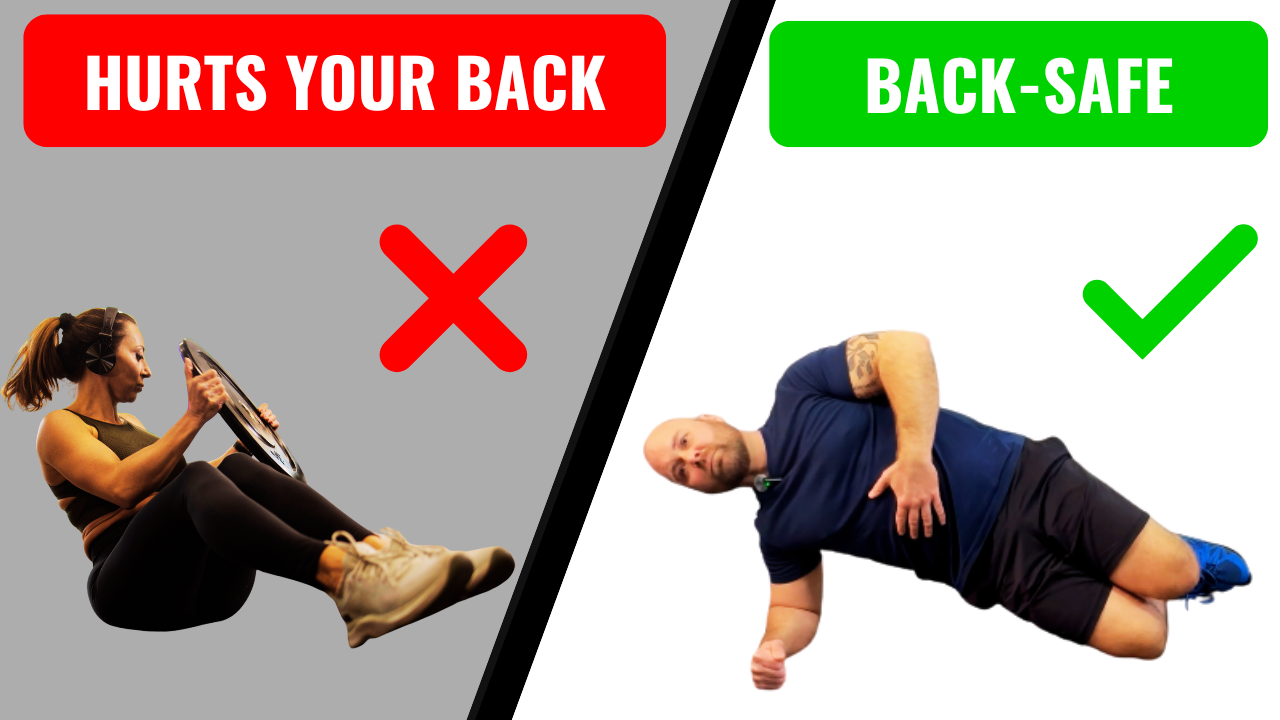
Avoid These Ab Exercises If You Have Back Pain
🎥 Prefer video? Watch the full version here
Some ab exercises can wreak havoc if you have a history of back pain. I know because I used to make the same mistake. That's why I'm going to show you three common movements to avoid — and two alternatives that can replace them.
- Forward Flexion Movements
These are your classic ab exercises where you flex your spine forward while rounding your low back. You'll see them all the time in the gym.
This includes:
- Sit-ups and all of their variations. Even if they don't hurt in the moment, they can cause wear and tear on your discs over time.
- Abdominal crunches and all their variations. These are often marketed as a safer alternative to sit-ups, but the truth is they still use the same spine-bending pattern and put stress on the discs.
- Weighted ab crunch machines. These are actually worse because now you're adding heavy compressive load on top of the bending. That's a recipe for problems.
So, here's the problem with that: You're combining a compressive load on the spine and forward flexion of the spine at the same time. This is the exact movement that causes most disc herniations.
When you're doing these exercises, you are repeatedly stretching the back part of the disc while compressing the front part of the disc. This causes a cumulative, damaging effect to that back part of the disc even if you don't feel it. And over time, this can lead to problems like annular tears, disc bulges, nerve compression, disc herniations — all sorts of problems.
👉 If you'd like to start learning how to avoid these kinds of movements in your daily life, I've put together a free mini course with four essential back-saving techniques. It's a great starting point, and you can find it here.
- Lateral Flexion Movements
This is similar to the forward flexion movements, except you're flexing your spine to the side, and it causes the same sorts of problems.
This includes:
- Any sort of resistance while bending to the side, like holding a dumbbell or a weighted cable.
This may seem harmless, but it's actually putting a ton of stress on your spine.
Here's why these aren't worth it: Once again, you're putting a compressive load on the spine while bending at the same time, except this time you're bending to the side. So, one side of your disc is getting compressed while the other side of the disc is getting repeatedly stretched. Again, that's going to accumulate damage.
- Rotation Through Your Spine
The problem here is not that your body is twisting — it's that you're aggressively twisting through your low back instead of rotating from the hips.
This includes:
- Ab rotation moves with a ball or with a weight, in a sit-up position leaning back slightly.
- Old ab rotation machines, which are still found in some gyms.
And frankly, these are a disaster for your low back.
So, here's the problem with these: You're combining a compressive load on your spine with forward flexion of your spine at the same time as rotating your spine. That's actually terrible for your spine.
Your spine is designed to handle load when it's in alignment. The discs are equipped to handle load, but once you start adding in that flexion and rotation with that load, the discs do not handle that nearly as well. And it's also the primary mechanism for a lot of disc herniations and a lot of problems.
Two Safer Alternatives
And now, as promised, here are two spine-safe exercises that can replace all these riskier ones.
- Ab Rollout
The first one is primarily for the muscles on the front of your stomach. My go-to exercise is the ab rollout. It's definitely advanced, so if you can't do it perfectly, don't worry. I'll show you an option that's easier in just a second.
But the rollout challenges all of your abdominal muscles at once by forcing your core to resist movement and stabilize the spine. I've personally replaced every single spine flexion exercise with this one, and I've never looked back.
Easier Option: The standard plank. There are endless variations for this, but I personally like holding it for short bursts and then adding challenges instead of trying to hold it forever, which really just gets boring. And if you need something even easier, planks can also be done on your knees. It's a great starting point to build strength safely while keeping your spine protected.
- Side Plank
The second exercise is primarily for the muscles on the side of your stomach. Side planks are a great choice. You can scale them up or down depending on your ability, such as on your feet or on your knees (easier version). They strengthen your obliques and your quadratus lumborum and even hit your glutes if you do them right — all without stressing your spine.
Final Note
If you've been wanting to get back into a routine, but you're concerned about making your back worse, I created a free mini course just for you. It covers four back-saving techniques that are the perfect starting point to protect your spine and move with more confidence. Click here to get it now.
About the Author
Dr. Matt Harris, DPT, MS, is a Doctor of Physical Therapy with 18+ years of experience helping people with spinal conditions. He provides straight-to-the-point back pain solutions — from recovery to lifelong lifting. No fluff. Just spine-safe training you can trust.
Having lived through his own back injuries and guided thousands of patients, Matt knows what it takes to go from pain and setbacks back to safe, confident training.
📩 Start your own recovery journey today: Get the free mini-course here.
